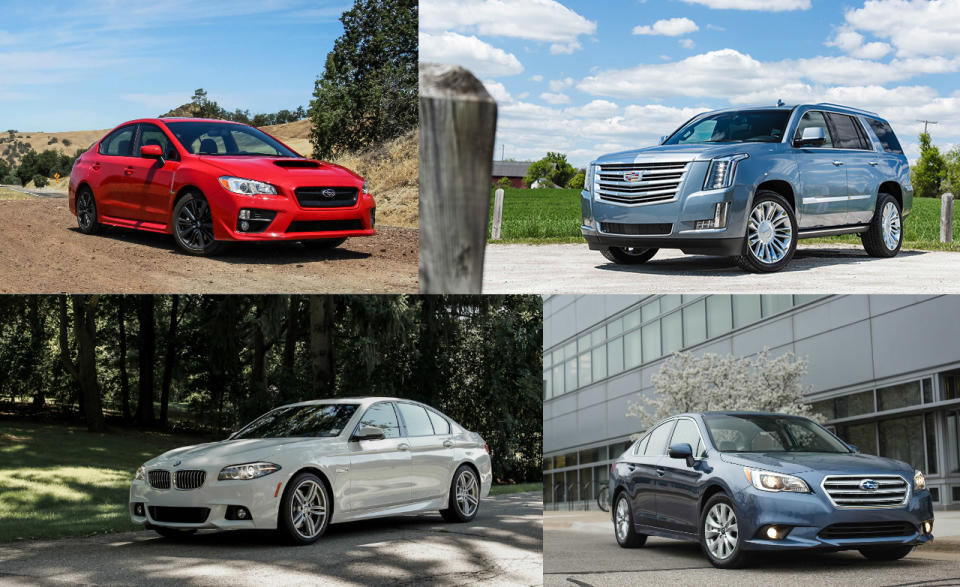The Rent Is Too Damn High, and By That I Mean Car Prices


From the October 2016 issue
The rent is too damn high. And by rent, I mean car prices. I’m given to the occasional gasp when I see a new car’s window sticker, but the last time I drove a Cadillac Escalade, I looked at the price and went into a fugue for days. I saw a number starting with a “9,” and I don’t remember anything until I woke with the room spinning and a doctor begging me to stop yelling, “It’s a Silverado with seats in the bed!” He was a good doctor. He told me, “Son, a Silverado can go 65 grand anyway, so settle down.” That made me feel better, I guess. But the question remains: Are car prices just going bonkers, or what?
Two years ago I got an email from Bankrate.com touting a study called “New Cars Unaffordable in All But One Major Metro Area.” It claimed that of the 25 largest metropolitan areas in the U.S., Washington, D.C., was the only one where a median-income family could afford to buy the average new car. (And by “afford” it meant putting down 20 percent and not financing it through the end of the Holocene Epoch.) I ignored this disturbing revelation because I ignore most of my emails, which are usually tagged with boring subjects like “Urgent story deadline” and “Report to HR to discuss your attire.” Delete! If somebody doesn’t like my vintage 1980s basketball shorts, they can tell me to my face at the cafeteria salad bar.
Anyway, Bankrate recently announced a follow-up study entitled “New Cars Are Unaffordable in All Major U.S. Cities.” This time it went 50 cities deep. In none of them could the median-income resident reasonably afford to spend $33,865, the current average price of a new car or light truck. You could say that’s an indictment of the urban cost-of-living index, and you might be right. But let’s look at car prices themselves, as viewed through the economically precise prism of random window stickers that I’ve happened to save over the years.
The oldest Monroney in my stack belongs to a 2004 BMW 545i that I drove to the Canadian Grand Prix. I can’t remember anyone’s birthday or my kids’ names, but I can remember barreling down a glorious I-93 on-ramp more than 12 years ago in that gray BMW. It had a manual transmission, sport package, and premium sound but was otherwise light on the options. Total price: $62,660. Simply adjusting for inflation, that 545i would now cost $79,954. So I go to BMW’s website and build a 2016 550i with the same options—no manual trans is offered, though—to find out just how much the price has blown past the rate of inflation. With the sport package, premium sound, and power rear sunshade (it still costs $575, just as it did in 2004), a 550i arrives at a total price of . . . $74,820. So the 5-series actually got cheaper, relative to everything else? This does not jibe with my keenly felt impression regarding the rent and its highness.

Clockwise from top left: Subaru WRX, Cadillac Escalade Platinum, BMW 535i xDrive, and Subaru Legacy.
Other pleasant surprises: Back in 2008, I drove a Volkswagen R32 that cost $35,430. A similarly equipped 2016 Golf R with navigation and DSG goes for $39,815. Which is almost exactly the inflation-adjusted price of the R32, but for a much faster, better- handling car that doesn’t sound like Chewbacca. Volkswagen would probably like to charge a little more for the flagship Golf, but the arrival of the Audi S3 means that it can’t, out of respect for brand boundaries. So thanks for the bargain Golf, Audi.
In at least one case, a price just straight-up dropped, even without factoring in inflation. My Monroney for the most expensive 2007 Subaru Legacy, the 2.5GT spec.B, carries a price of $34,620. The current top-dog Legacy, the 3.6R, costs only $32,460. Sure, this isn’t a totally apples-to-inverted-Bilsteins comparison, but it demonstrates Subie’s commitment to a lean MSRP. Subaru’s unstoppable growth in recent years probably has at least a little bit to do with the fact that every one of its models still seems reasonably priced. It’s easy to spend 50 grand on a car, but there is still no such thing as a $50,000 Subaru.
Cars are looking okay then, based on my admittedly scattershot sample. Trucks and SUVs are another matter. Six years ago, I drove a Ram 3500 Cummins dualie that cost $35,855. Inflation suggests that this truck should now cost a little less than $40,000. Nope. Buying a similar 2016 model now requires $48,435.
In 2008, I drove a Porsche Cayenne that carried a base price of $44,295. Nowadays a Cayenne starts at $60,650, meaning that the Porsche’s price increases outpaced inflation by a factor of more than three. And then there’s the Escalade. In 2008 I drove a fully maxed-out 4x4 hybrid that ran $75,330. Now a totally slathered ’Slade goes for more than $94,000. And it’s not a hybrid. I mean, the Escalade’s a baller and all, but I fear GM is in danger of overfishing this particular sea of profit.
I’m not an economist, but I vaguely grasp the idea of supply and demand. And it would seem that trucks are in demand and priced accordingly, and cars are kind of a bargain, and cities are real expensive places to live. The rent is, in fact, too damn high. But a Subaru WRX is still a pretty nice deal.

 Yahoo Autos
Yahoo Autos 